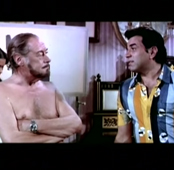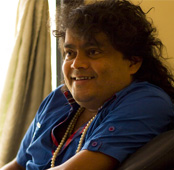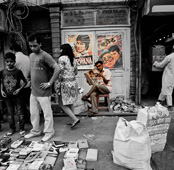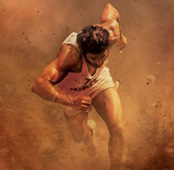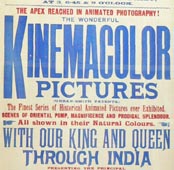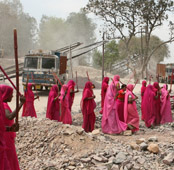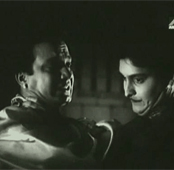-
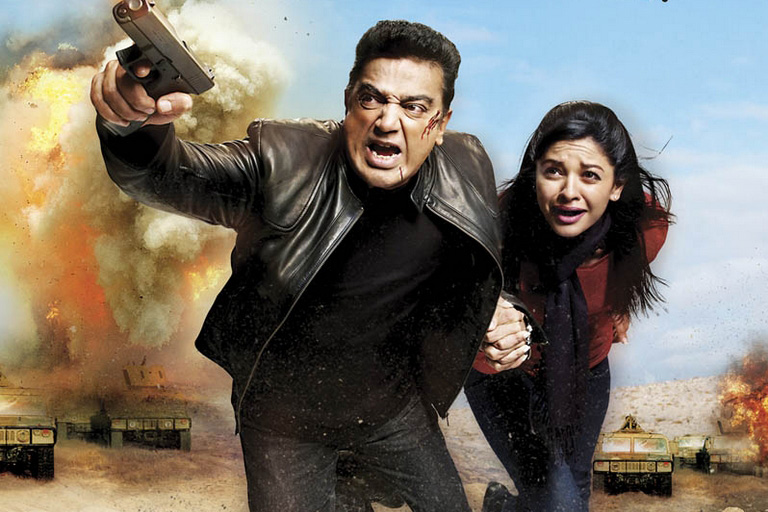 Poster of Vishwaroopam
Poster of Vishwaroopam -
 Drew Barrymore in Scream
Drew Barrymore in Scream -
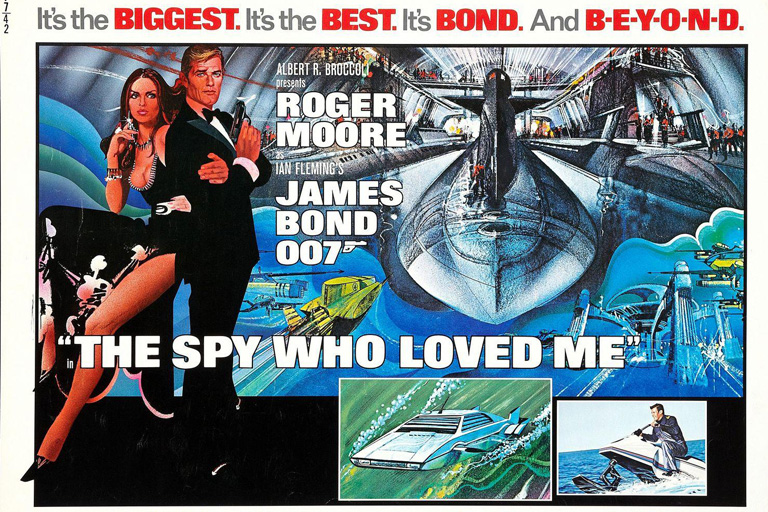 Poster of Spy Who Loved Me
Poster of Spy Who Loved Me -
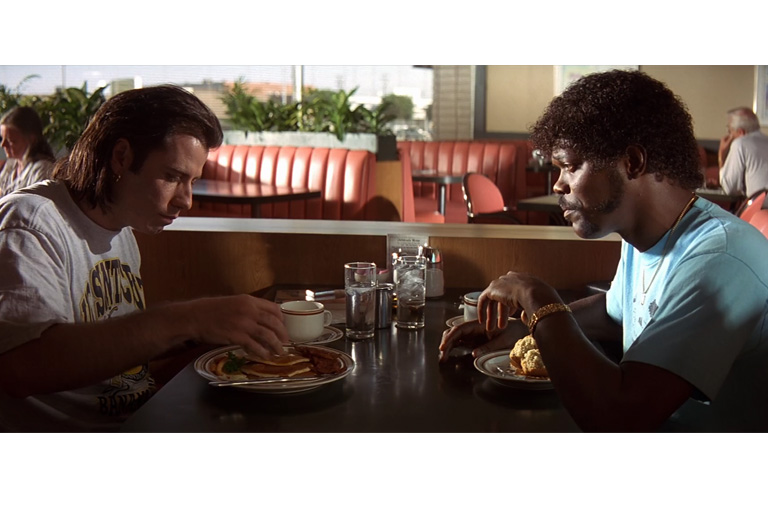 Still from Pulp Fiction
Still from Pulp Fiction -
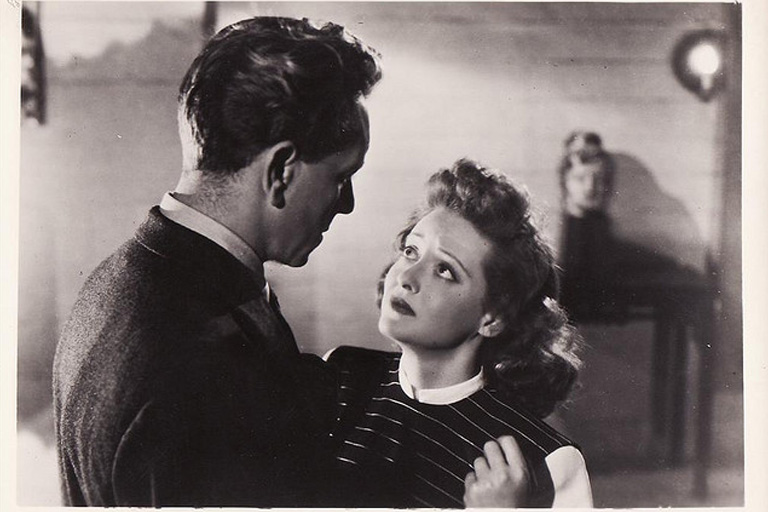 Still from Deception
Still from Deception -
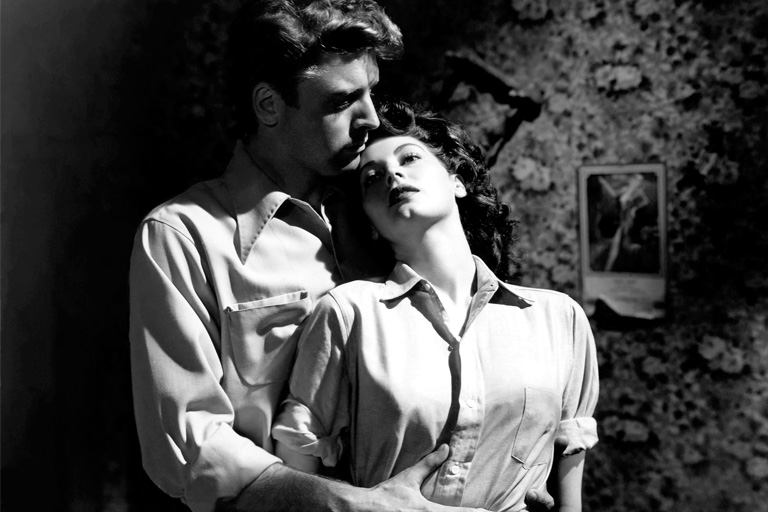 Still from Killers
Still from Killers
Zac O’Yeah on how Indian cinema, unlike Western cinema, challenges the idea of genre, and how this can be traced back to the theatrical roots of each.
There’s no doubt about it— Kamal Haasan’s Vishwaroopam (2013), which he wrote, directed, co-produced and starred in, is an out and out action blockbuster on par with the most spectacular Hollywood thrillers of all time. Yet, for the first 41 minutes of its running time of two hours and something, the character Viz, played by the versatile superstar himself, is actually a comic one: a caricatured, cuckolded teacher of Indian dance in America, whose clownish antics have driven his attractive wife, Nirupama (played by model Pooja Kumar), to seek out a therapist and a private eye (specializing in divorce cases), resulting in a series of events that make the couple end up in genuinely unsavoury company.
It’s only in the 42nd minute, as Viz and Nirupama are about to be slaughtered by a group of hardcore terrorists, that he loses his deep cover and reveals his true identity as a virtual one-man army, the toughest bare-hands killing machine in cinema history, disposing of his enemies down to the last man. Nirupama then realizes that her husband is a true hero, and so do we in the audience.
My point is not that Kamal Haasan clowns around a bit in his own movie—his track record includes many hit comedies as well as romantic roles in a very long and distinguished career—but rather that he mixes comedy with thriller, and highly successfully too. So when the silly dance guru cuts off his flowing locks before the bathroom mirror and turns into the powerful superhero, I totally buy it.
And it occurs to me that I’ve rarely seen anything like this in Western cinema. Could it be because comic relief and elements of slapstick are normally expected to defuse whatever suspense a thriller may laboriously be building up? This may explain why humorous elements are treated with utmost care in Hollywood cinema. If a Western movie opened in the manner of Vishwaroopam, it would have stayed there—in comedy land—rather than switching genre midway. But here the switch is made remarkably effortlessly from a domestic comedy of errors to an international high-tension war-zone thriller of terrors, as if the home and the world were but different facets of our complex daily lives.
This is not to say that Western thrillers never have humour in them. Comic effects are frequently used in horror cinema. Shock-slash-guffaw is a thoroughly exploited formula in, for example, the top-grossing Scream franchise, which went on to inspire the early 2000s spoof series Scary Movie. You might recall that Wes Craven’s original Scream (1996) was a spectacularly self-conscious satire on horror genre tropes— starting with that “What’s your favourite scary movie?” quiz which the prank caller subjects Drew Barrymore to before the slashing begins. But the fact remains that most horror movies, through horror history, have taken themselves with deadly seriousness.
As for Hollywood films that blend comedy and crime genres, the only memorable one I can think of is Dead Men Don’t Wear Plaid (1982), starring comedian Steve Martin as a detective. This is more of a film buff’s film, where Martin (shot in intense black-and-white) interacts with a selection of classic clips from vintage Hollywood noir. There’s no actual suspense, though, and the thrills (and jokes) consist of the juxtaposition of unconnected typical pulp thriller scenes (Humphrey Bogart in The Big Sleep, Bette Davis in Deception, Burt Lancaster in The Killers, Veronica Lake in The Glass Key and fourteen other genre classics) loosely held together by Martin’s private eye navigating through the mix. The whole film is a gag.

Other than that what’s funny about modern Western action? The Indiana Jones flicks were action-packed and occasionally bizarrely funny, granted, but essentially they paid homage to the swashbuckling heroics of 1930s Saturday matinee yarns— so whatever they were, they weren’t comedies. The same goes for Quentin Tarantino’s films. The epic Pulp Fiction (1994) made us see modern Hollywood in a fresh light, but no matter how riddled it is with memorable and macabre gags, it really is a homage to classic gangster pulp. Whatever comic effects Tarantino uses in his films operate to intellectualize the action and make the viewer step back so as to analyze what’s happening on screen.
The truth seems to be that Western action flicks can contain fun sequences but steer clear of out and out comedy. Humour, if incorporated, comes in minimal doses. One of my personal classics is the ski chase in The Spy Who Loved Me (1977) when James Bond (Roger Moore) escapes the Soviet agents by jumping off the Alps— in what was, at the time, the most expensive stunt ever filmed. Just as we think this is goodbye to 007, a Union Jack parachute unfurls from his backpack. But even if some critics view the James Bond franchise in its entirety as ridiculous and campy, as in this scene, it wasn’t the intention of the filmmakers to make spy spoof flicks.
It is quite another matter that the James Bond films spawned several genre parodies, perhaps most notably those with Mike Myers’s Austin Powers character (featured in films like The Spy Who Shagged Me and Austin Powers in Goldmember), but their action quotient doesn’t count for much if we try to watch them as thrillers.
Another great instance of limited fun that comes to mind is the acerbic wit of Clint Eastwood in the 1970s ‘Dirty Harry’ cop movies (“I know what you’re thinking… Did he fire six shots, or only five? Well, to tell you the truth, I forgot myself in all this excitement… ”) or the low key way in which Eastwood, playing the aged, reformed gunslinger William Munny, falls off his horse in the Academy Award-winning Unforgiven (1992). The grim-jawed one liner cracked by an action hero in the midst of nail-biting drama was developed further in the Die Hard series starring Bruce Willis (starting with Die Hard way back in 1988 and followed by several sequels including A Good Day to Die Hard in 2013), where our streetwise NYPD hero often stops, when the thrills peak, for a fraction of a second, to quip about something— usually along the lines of “this is a bad, bad, bad idea” before he jumps down an elevator shaft or out of the window of a skyscraper. But these are small instances of lightness in essentially dark, violent films, and that’s as much fun as it generally gets in your typical Western action.
Meanwhile, in Indian cinema, broad-spectrum entertainment seems to be what it’s all about. When watching action heroes like Shah Rukh Khan or Sanjay Dutt, I’m usually clinging on to the seat at the end of the show, my heart rate irregular from pumping too much adrenaline, my eyes sore from crying during the sentimental scenes, but also—significantly—my stomach aching from having laughed a lot.
Comedy or suspense? As I look back at a number of favourites from over the decades, films that for one reason or the other have stuck in the mind, I really find it hard to say if I was watching comedies or thrillers.
Yash Chopra’s final epic Jab Tak Hai Jaan (2012), for example, is a romantic drama-comedy about the joys and hardships of immigrant life in London, true, but the opening scenes of the film actually show Shah Rukh Khan as the cynical hero in battle fatigues (the character he later becomes after love disappointments): a major portion of the plot is centred around his career as a tough bomb-defusing expert hanging under booby-trapped bridges. Before that there was Delhi Belly (2011)— we may remember it as a disgustingly funny black comedy of unrefined toilet humour, but underpinning it there’s a solid thriller centred around a dangerous smuggled package. A special cinematic treat in the film is Vijay Raaz as a memorably sinister gangster. One of the funniest Wild West farces I’ve seen is Quick Gun Murugan (2009)— which is at the same time a hardboiled gunslinger action with remarkable shootouts, as well as being centred around a vegetarian cowboy (Rajendra Prasad) who tries to stop the creation of the ultimate non-veg dosa. Before that there was Munna Bhai MBBS (2003)— brutal slapstick where a gangster don (Sanjay Dutt) has to redeem himself by going to medical college; come to think of it, Dutt has an unrivalled talent for acting the clown and also the tough guy (rivaled perhaps only by Kamal Haasan, who remade this gangster comedy as Vasool Raja MBBS in the south). A couple of years earlier there was the Kannada hit film Upendra (1999), a violently funny but also intense psychological gangster movie by superstar Upendra who wrote, directed and starred in it. Here the witty actor-director plays the rowdy Naanu who smokes “filter bidis” (bidis tucked into filters torn off cigarettes) and sees the world through “cooling glasses” (shades).
The oldest example I can think of right now is Kundan Shah’s satirical Jaane Bhi Do Yaaro (1983)— a goofy comedy about bumbling photo journalists (Naseeruddin Shah and Ravi Baswani), but on the other hand a cult detective movie with pretty macabre sequences in which a dead corpse is carted around town.
Although this essay isn’t based on statistical analysis, I’m sure it is possible to come up with many more examples of comic thrillers or thrilling comedies. We laugh our hearts out but enjoy the hard-hitting action, and we’re horrified by the violence. Notably, many of the above actors, although expert comedians, aren’t typecast as comic characters— most of them are equally comfortable doing serious roles. How is this possible?
It is the caricatured dance teacher in Vishwaroopam who might hold a key to unravelling this cinematic mystery. The theatrical emotions that Kamal Haasan plays out in the dance class, taught to him—incidentally—by the Kathak maestro, Birju Maharaj, himself, hint to us that this might be one movie appreciated best if we lean back and think. Hassan’s classical dance moves take us back to the Natya Shastra, the famous, ancient Indian treatise on the performing arts. But what do these more than 2000 year old codifications have to do with 21st century cinema?
From the ancient Indian theory about dance, theatre and music, we learn that any artistic performance must have a dominant mood, a rasa, built out of emotions (bhavas) of which there are eight in number (in addition to which there’s also shanti, or peace, which is the ninth and the opposite of the other eight bhavas). A subtle mixing of the component bhavas, displayed in different segments of the work, serves to create the ultimate rasa or emotional response in the viewer.
One of these components is comedy (hasya), but others include terror or thrills (bhayanaka) and, of course, there’s heroism (vira) and love (rati). Natya Shastra explains in detail how each of these particular emotions is conveyed to the audience.
After the performance, having gone through the emotional turmoil thus produced, the audience experiences shanti or peace, calm, inner purity, insight, which glimpses the truth of life. A performance is judged by its success on this precise count. This very matrix, constructed two millennia before Bollywood was born, can give us a fascinating analytical tool to separate the various elements of a modern Indian film, and understand how components that would oppose each other in Western cinema, actually interlock and produce—through the friction created between opposites—a singular and unique greater experience.
By contrast, Hollywood cinema seems to operate according to the classic strictures of ‘the dramatic unities’ such as they were expounded by ancient art critics starting from the time of Aristotle through to the Renaissance. In about 17th century Europe, this resulted in an extreme purism in the interest of creating a semblance of credibility, particularly strongly expressed in French classicism which rejected all hybrid art forms, such as tragicomedy for example. In the olden days a staged play therefore had to confine itself within a rigorously delineated timeframe, social circumstance, and so on. Although modern cinema isn’t bound by these traditional unities, there remains in Hollywood filmmaking that same strong sense of a formal unity of plot with a single, central, pivotal action at its base: hence an action flick is a thriller and not a comedy, and vice versa. Incredible as it may sound, this tendency, that can be traced back to the 3rd century B. C. philosopher Aristotle, remains very much alive today. Check out Quentin Tarantino’s directorial debut, the iconic Reservoir Dogs (1992) or the more mainstream, claustrophobic David Fincher thriller Panic Room (2002) starring Jodie Foster for extreme cases of adherence to these dramatic unities.
These tendencies that I’m discussing here aren’t absolute or exclusive, of course. There are also clear parallels between Indian and Western films— both types of cinema aim at taking us through classic cathartic experiences, for one. Hollywood and Indian cinema have influenced each other through the years, and there are many Indian films that are rather Western in their expression.
All the same, the hallmark of the Western tradition is that it tends to focus on a single emotion, whereas the Indian tradition not only has space for many more bhavas, but we expect this particular quality from the films— they must operate on all possible emotional levels, speak to the whole body, the brain, the heart, the guts, the groin, as well as the funny bone.
Like life itself, the Indian hero (and the heroine too) is complex: consisting of one part heroics, one part love, one part comedy, and so on. We in the audience are all smaller versions of our multi-tasking heroes. Paradoxically, the Western cinema’s attempt at achieving lifelikeness through its dramatic unities and purer realism may to some extent actually be less close to the viewer’s real life.
So, therefore, a typical Indian film contains, within itself, the elements of every other cinematic genre: a romantic movie will also have a villain who plots to do nefarious mischief as well as a clown who makes us laugh until we cry. A comedy is also likely to have heroics of the nail-biting kind, as well as a romantic element which will bring tears to our eyes. And the action film, too, will have serious comic elements in it, the latter seeming to enhance the thrills rather than defusing them— as we Indian cinema-goers very well know. If a Western film attempts the same, critics and audiences are likely to judge it as being all over the place; it is impossible to imagine Sylvester Stallone sing, dance and horse around on a mountain slope, and then go on a shooting spree. But this same impossibility is not only possible in India, it is the prerequisite of any really great movie.
Lights! Camera! Everything!
ArticleApril 2014
 By Zac O'Yeah
By Zac O'Yeah
Zac O’Yeah used to work at a theatre in Gothenburg, Sweden, a harbor town where his detective novel 'Once Upon A Time In Scandinavistan' is set, and toured with a pop group, until he retired early at 25 and came to India. Since then he has published 12 books in Swedish, many of them bestsellers, including the Gandhi biography 'Mahatma!' which was short-listed for the August Prize, 2008, for 'Best Nonfiction Book of the Year'. His most recent book is the comic thriller 'Mr. Majestic!', which has been written in English, Swedish and German. He is currently working on a new thriller and a film project. He is also a literary critic (rather grumpy at that) and columnist, who has written on crime fiction in the Mint Lounge, and contributed now and then to travel magazines such as National Geographic and Outlook Traveller, as well as major Swedish magazines and newspapers. O’Yeah is also a translator specializing in introducing selections of Indian writing—such as Pankaj Mishra, Bankim Chandra Chatterjee and others—to Swedish readers. He has had a long involvement with theatre in as a playwright, director, designer, producer, and occasional performer. He has been a cultural consultant for several bilateral exchange projects involving Swedish and Indian writers, translators, theatre workers and many others who toil in the fields of art. Previous jobs include International Secretary of the Swedish Writers’ Union (1998-2000), dance lighting designer (1988-1992) and dish washer in a seedy pizzeria in Kungsportsavenyn (1986-1987). He lives in India and is married to the author Anjum Hasan.



